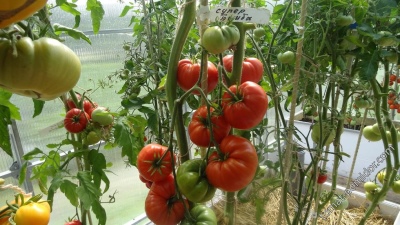
- Authors: Dederko V.N.
- Year of approval: 2017
- Category: grade
- Growth type: determinant
- Appointment: universal
- Ripening period: mid-season
- Ripening time, days: 110-115
- Growing conditions: for open ground, for film greenhouses
- Marketability: high
- Bush size: medium-sized
The Superbomba tomato variety was approved for use in 2017. It is suitable for planting and growing outdoors, as well as in greenhouses and greenhouses.
Description of the variety
The superbomb is a versatile variety. His type of growth is determinant. This productive variety is highly marketable.
The bushes are medium-sized. Plant height can reach up to 150 cm in greenhouses and 100 cm outdoors. The leaf plates are of medium length, their color is light green.
The main qualities of the fruit
Unripe fruits are light green in color with a green spot on the base. Ripe tomato color is red. Each vegetable is quite large in size, the mass of one fruit can be from 300 to 600 grams.
One brush can contain 5-6 tomatoes. Their pulp is fleshy of medium density. Their shape is flat-round, medium-silvery. The inflorescence is simple.
Taste characteristics
Superbomb boasts excellent taste. Often this variety is used in the preparation of a variety of salads, juices and sauces.
Ripening and fruiting
This variety is mid-season. It ripens in about 110-115 days after planting in the ground.
Yield
The superbomb is a high-yielding species. From one bush, you can get an average of 7 kilograms of tomatoes. From 1 square meter, you can collect about 10.1-10.2 kilograms.
The timing of planting seedlings and planting in the ground
Sowing seedlings should be done in late March - early April. Planting in the ground is best done when the seedlings are 60-65 days old.

Growing tomato seedlings is an extremely important process, because it largely depends on whether the gardener can harvest at all. All aspects must be taken into account, from seedbed preparation to planting in the ground.
Landing scheme
This variety should be planted according to the scheme 70 by 30-40 centimeters.

Growing and care
First, you will need to grow healthy and strong seedlings. To do this, you need containers for planting. Disposable plastic cups are most commonly used. They also prepare the ground. You need to use the soil from the garden. It is pre-mixed with organic feeding. And also it is worth moisturizing.
After that, the earth is laid out in containers. The seeds are laid out on top and then deepened a little. Further, all this must be placed on the most well-lit windowsill, since the seedlings prefer bright places.
The soil will need to be moistened regularly, it should always be moist. Vegetation will also need additional feeding. They should be applied every 2-3 weeks. In this case, organic nutrients (with herbs, with manure) will be best suited.
After 60-65 days, they are planted in open ground.The best option for these tomatoes will be fertile chernozem soils. It is better to mix them with peat beforehand. Young seedlings can be additionally treated with growth stimulants and disinfectants.
It is recommended to disembark in cloudy calm weather. You need to plant seedlings, deepening the stem a couple of centimeters. After a few days, new small roots will begin to appear on the stem. At the same time, the entire root system will become much stronger.
After planting, the vegetation must be watered with warm water. In order for plants to be able to give a full harvest, it is important to remember about caring for them. This crop will need watering. It is carried out as the topsoil dries up. In this case, the procedure is carried out strictly at the root.
Top dressing also plays an important role. The first time the culture must be fertilized during the period when it begins to actively gain green mass. The best option in this case would be a solution with ammonium nitrate or potassium sulfate. One bush should have about 3 liters of composition.
The second top dressing should be applied after about 25-30 days. You can use the same fertilizers and in the same proportions. Sometimes an infusion with wood ash is also used. To prepare it, you need to mix two glasses of ash and 10 liters of water. In this form, everyone insists for 5-6 hours. After this time, the ready-made composition is used for watering at the root. This procedure is done throughout the summer season at intervals of 10 days.
It is also important to form the bushes correctly, as they grow quite strongly. It will be necessary to remove stepchildren in a timely manner. They should not be more than 5 centimeters long.
Do not forget to regularly process the soil around the bushes. She will need loosening, weeding and mulching. Coniferous sawdust is most often used as mulch.




A plant needs different micronutrients at each stage of growth. All fertilizers can be divided into two groups: mineral and organic. Folk remedies are often used: iodine, yeast, bird droppings, eggshells.
It is important to observe the rate and period of feeding. This also applies to folk remedies and organic fertilizers.


Review overview
Many gardeners have left positive reviews about Superbomb tomatoes. So, it was said that this variety has powerful and strong stems. It allows you to get a large harvest. All the fruits are very large with juicy pulp.
And also the gardeners noted that the Superbomb has excellent taste. Plucked ripe fruits can be stored for a long time without losing their taste.

























































































